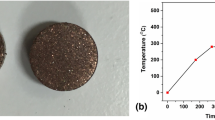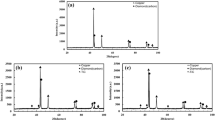Abstract
This paper describes the development of a novel polycrystalline diamond fiber that has attractive isotropic thermal properties at a moderate cost. The fiber is processed first by chemical vapor deposition (CVD) and then by microwave plasma-enhanced CVD. Using the fiber as a reinforcement for metal-matrix composites offers numerous advantages in terms of engineering properties (e.g., a coefficient of thermal expansion that can be tailored to match the values of semiconductor materials, an enhanced thermal conductivity, and light weight). The resulting composites have a great potential for application in the thermal management of electronic devices.
Similar content being viewed by others
References
J.E. Field, The Properties of Diamond (New York: Academic Press, 1979).
D.V. Fedoseev, V.P. Varnin, and B.V. Deryyagin, Russ. Chem., Rev. (English Trans.) 53(5) (1984), pp. 435–444.
A.A. Morrish et al., Proceedings of the Third International Symposium on Diamond Materials (Pennineton, NT: Electrochemical Society, 1993), p. 854.
P.W. May et al., “The Production of Diamond Tubes and Fibers,” in Ref. 3, p. 1036.
R.T.K. Baker and P.S. Harris, Chemistry and Physics of Carbon (New York: Dekker, 1978), p. 83.
G.G. Tibbetts, M. Endo, and C.P. Beetz, SAMPE Journal (September/October 1983), pp. 30–35.
M. Endo and K. Komaki, Extended Abstracts, 16th Biennial Conference on Carbon, San Diego, CA (1983), p. 523.
G.G. Tibbetts, Carbon, 30 (1992), p. 399.
J. Heremans and C.P. Beetz, J. Phys. Rev. B, 32 (1985), p. 1981.
J.-M. Ting and M.L. Lake, J. Mat. Res., 9(3) (1994).
J.-M. Ting and M.L. Lake, Diamond and Related materials, to be published.
M.L. Lake, J.-M. Ting, and J.F. Phillips, Jr., Surf. Coat. Techn., 62 (1993), p. 367.
B.V. Deryagin and D.V. Fedoseev, Growth of Diamond and Graphite from the Gas Phase (Moscow: Nauka, 1977).
J. Angus, Diamond Films '91 (Nice, France: 1991).
T. Suzuki et al, Wayne State University Third Annual Diamond Technology Workshop (March 1992).
J.J. Dubray, CG. Pantano, and W.A. Yarbrough, J. Appl. Phys., 72(7) (1992), p. 3136.
W.B. Johnson and B. Sonuparlak, “Diamond/Al Metal Matrix Composites formed by the Pressureless Metal Infiltration Process,” J. Mater. Res., 8(5) (May 1993).
J.R. Guth and M.L. Lake, “Pyrolytic Carbon Fiber/Al uminum Composites,” The 17th Conference on Metal Matrix, Carbon, and Ceramic Matrix Composites (NASA, 1993).
J.E. Graebner et al, Nature, 359 (1992), p. 401.
J.E. Graebner et al., “Thermal Conductivity and the Microstructure of State-of-the-Art Chemical-Vapor-Deposited (CVD) Diamond,” Diamond and Related materials, 2 (1993), pp. 1059–1063.
J.V. Busch and J.P. Dismukes, “Economics of CVD Diamond,” in Ref. 3, p. 880.
Author information
Authors and Affiliations
Rights and permissions
About this article
Cite this article
Ting, JM., Lake, M.L. Polycrystalline diamond fibers for metal-matrix composites. JOM 46, 23–25 (1994). https://doi.org/10.1007/BF03220644
Issue Date:
DOI: https://doi.org/10.1007/BF03220644




